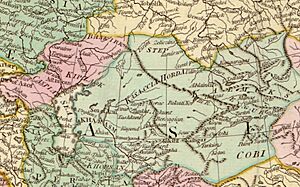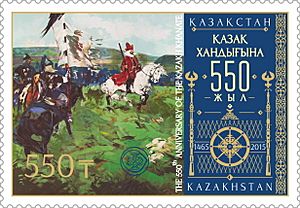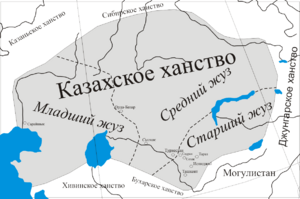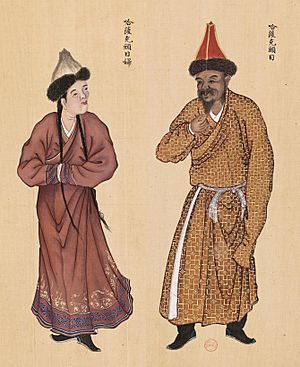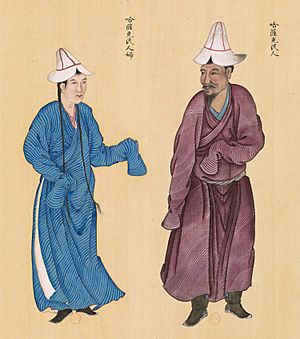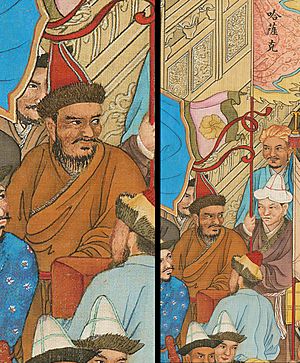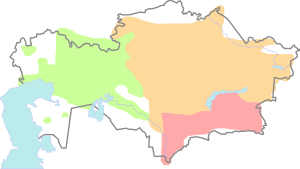Kazakh Khanate facts for kids
Quick facts for kids
Kazakh Khanate
Қазақ Хандығы
Qazaq Handyğy قازاق حاندىغى |
|||||||||||
|---|---|---|---|---|---|---|---|---|---|---|---|
| 1465–1847 | |||||||||||
| Capital |
|
||||||||||
| Common languages | Kipchak languages (Kazakh) | ||||||||||
| Religion | Sunni Islam | ||||||||||
| Demonym(s) | Kazakh | ||||||||||
| Government | Semi-elective monarchy | ||||||||||
| Khan | |||||||||||
|
• 1465–1480
|
Kerei Khan (first) Janibek Khan |
||||||||||
|
• 1841–1847
|
Kenesary Khan (last) | ||||||||||
| History | |||||||||||
|
• Kerei and Janibek founded the Kazakh Khanate
|
1465 | ||||||||||
|
• Kazakh-Dzungar Wars
|
1643-1755 | ||||||||||
|
• Battle of Orbulaq
|
1643 | ||||||||||
|
• The invasion of Galdan Boshogtu Khan to Kazakhs
|
1680-1684 | ||||||||||
|
• The Barefooted Flight
|
1723–1727 | ||||||||||
|
• Battle of Añyraqai
|
1729/1730 | ||||||||||
|
• Abulkhair Khan of the Junior Zhuz took Russian citizenship
|
1731 | ||||||||||
|
• Kazakh-Qing Wars
|
1756-1757 | ||||||||||
|
• Abylai became the khan of all three zhuzes
|
1771–1781 | ||||||||||
|
• Dissolution of the Khan's rule in the Middle Zhuz and Junior Zhuz
|
1822-1824 | ||||||||||
|
• Rebellion of Kenesary Kasymov
|
1837–1847 | ||||||||||
|
• Russian conquest
|
1847 | ||||||||||
|
|||||||||||
The Kazakh Khanate was a powerful Kazakh state in Central Asia. It existed from the 15th to the 19th century. This khanate was a successor to the Golden Horde, a large Mongol-led empire. It was mainly located in the eastern parts of a region called Desht-i Qipchaq.
Two cousins, Janibek Khan and Kerei Khan, founded the khanate in 1465. They belonged to the Turco-Mongol Tore clan, which traced its family line back to Genghis Khan. The Tore clan continued to rule the Kazakh Khanate until it became part of the Russian Empire.
From the 16th to the 17th century, the Kazakh Khanate grew its lands. It expanded into modern-day West Kazakhstan, much of Uzbekistan, Karakalpakstan, and along the Syr Darya river. It even reached areas now in Russia and Iran. Later, the khanate became weaker due to attacks from Oirats and the Dzungar Khanate. This led to its split into three main parts called Juzes. These parts slowly lost their independence and were taken over by the expanding Russian Empire in the 1800s.
The creation of the Kazakh Khanate was a major step for Kazakh statehood. Its 550th anniversary was celebrated in 2015.
Contents
- History of the Kazakh Khanate
- Khans of the Kazakh Khanate
- See also
History of the Kazakh Khanate
In 1227, a state called the White Horde formed within the larger Golden Horde. After 1361, the White Horde became independent for a while. However, after the death of Barak Khan in 1428, the Golden Horde broke apart. The White Horde also split into the Uzbek Khanate and the Nogai Horde.
The Uzbek Khanate, which covered most of modern Kazakhstan, was ruled by Abu'l-Khayr Khan. His rule was often troubled by internal problems. The khanate also faced raids from the Oirats, who attacked cities and nomadic camps. In 1457, Abu'l-Khayr Khan suffered a big defeat against the Oirats, which hurt his reputation.
How the Kazakh Khanate Began
The Kazakh Khanate started to form in 1459. Many Kazakh tribes were unhappy with Abu’l-Khayr Khan's rule. So, Janibek Khan and Kerei Khan, who were cousins, led these tribes away. This event is known as the Great Migration.
They moved towards Moghulistan, where they settled and created their own independent state. The Khan of Moghulistan supported them. About 200,000 nomads joined Janibek and Kerei, making their movement very powerful. This new khanate became a buffer zone between Moghulistan and the Uzbek Khanate.
Janibek Khan and Kerei Khan are both seen as founders. However, Janibek Khan held more power at first. In 1468, Janibek invaded the Uzbek Khanate, starting the Kazakh War of Independence. Abu’l-Khayr died on his way to fight the Kazakhs. After Kerei Khan's death around 1473-1474, Janibek Khan became the sole ruler.
The early years of the Kazakh Khanate involved fighting for control of the steppe. They fought against Muhammad Shaybani, Abu'l-Khayr's grandson. In 1470, the Kazakhs defeated Shaybani at Iasy (now Turkistan). This forced the Uzbeks to move south.
In 1480, Kerei Khan's son, Burunduk, became khan. Under his rule, the Kazakhs gathered a large army. They repeatedly defeated Muhammad Shaybani's forces along the Syr Darya river. In 1500, the Uzbeks made peace with the Kazakhs. This gave all the former Uzbek Khanate lands north of Syr Darya to the Kazakh Khanate.
A historian named Khaidar Duglati wrote about these events in the 16th century:
At that time, Abulkhair Khan exercised full power in Dasht-i-Kipchak. He had been at war with the Sultánis of Juji; while Jáni Beg Khán and Karáy Khán fled before him into Moghulistán. Isán Bughá Khán received them with great honor, and delivered over to them Kuzi Báshi, which is near Chu, on the western limit of Moghulistán, where they dwelt in peace and content. On the death of Abulkhair Khán the Ulus of the Uzbegs fell into confusion, and constant strife arose among them. Most of them joined the party of Karáy Khán and Jáni Beg Khán. They numbered about 200,000 persons, and received the name of Uzbeg-Kazák. The Kazák Sultáns began to reign in the year 870 [1465–1466] (but God knows best), and they continued to enjoy absolute power in the greater part of Uzbegistán, till the year 940 [1533–1534 A. D.].
Growth of the Kazakh Khanate
Kasym, son of Janibek Khan, became Khan in 1511. From then on, only Janibek Khan's descendants ruled the Kazakh Khanate. Under Kasym Khan, the khanate became very strong. The Nogai Horde, a rival group, became its main enemy.
Kasym successfully captured the Nogai capital, Saray-Juk, in 1520. This pushed the Nogai Horde towards the Astrakhan Khanate. Under Kasym Khan, the borders of the Kazakh Khanate expanded greatly. Its population reached 1 million people. During his rule, the Kazakh Khanate became well-known and important in the Euro-Asian region.
Kasym Khan also supported arts, literature, and religion. Islam became very important in Kazakh society. The Tsardom of Russia was the first major state to form diplomatic ties with the Kazakh Khanate during his reign. This showed Kasym Khan's success as a leader.
Kasym Khan also created the first Kazakh code of laws in 1520. It was called "Қасым ханның қасқа жолы," meaning "Bright Road of Kasym Khan." He also made an alliance with the Timurid leader Babur.
Mirza Muhammad Haidar wrote about Kasym Khan:
Kásim Khán subdued the whole of the Dasht-i-Kipchák. His army numbered more than a million [a thousand thousand] men. Excepting Juji Khán, there had never reigned a greater Khan than he in that country.
Challenges and Civil War
After Kasym Khan died, the Nogaiys took back their lands west of the Turgai River. The Kazakh Khanate then focused on the areas of Zhetysu and South Kazakhstan, where conflicts began. The central part of Kazakhstan, Sary-Arka, was only loosely part of the khanate. The Khanate of Sibir took control of the northern regions of Sary-Arka.
When Tahir Khan became the Kazakh ruler, the Oirats invaded. They captured eastern parts of Sary Arka in the 1520s. In the early 1530s, a civil war broke out among Janibek Khan's grandsons. Haqnazar Khan won and reunited the khanate.
Haqnazar Khan (1537–1580)
Under Haqnazar Khan, the Kazakh Khanate faced challenges from many sides. These included the Nogai Horde in the west, the Khanate of Sibir in the north, Moghulistan in the east, and the Khanate of Bukhara in the south.
Haqnazar Khan worked to free occupied Kazakh lands. He brought the northern regions of Sary-Arka back into the Kazakh Khanate. He also fought against the Nogai Horde and recaptured Saraishyk. The Kazakhs also took the Mangyshlak peninsula from the Khivans and pushed back the Oirats. Haqnazar also campaigned against Moghulistan to fully add Zhetysu to the khanate. This campaign was successful.
In 1568, the Kazakhs defeated the Nogai Horde at the Emba River. They reached Astrakhan but were stopped by Russian forces.
Shygai Khan (1580–1582)
Shygai Khan ruled for a short time, from 1580 to 1582. He was the grandson of Zhanibek Khan. Even though he was eighty years old, he was a respected leader. Shygai Khan continued the foreign policy of Haqnazar Khan. He used conflicts between rival groups to strengthen the Kazakh state.
In 1582, Shygai Khan, his son Tauekel Sultan, and Bukhara Khan Abdullah joined forces. They attacked Baba Sultan, the ruler of Tashkent. Baba Sultan was defeated and fled. Shygai Khan died during this campaign.
Tauekel Khan (1582–1598)
Tauekel Khan expanded the Kazakh Khanate's control over cities like Tashkent, Fergana, Andijan, and Samarkand. In 1598, Kazakh forces reached Bukhara and surrounded it for 12 days. However, the Bukharan leader Pir-Muhammad and his brother Baki-Muhammad pushed the Kazakhs back. Tauekel Khan was wounded in this battle and died while retreating to Tashkent.
Esim Khan (1598–1628)
After Tauekel Khan's death, Esim Sultan became Khan. He was known as "Ensegei boily er Esim," meaning "very tall man - Esim." His rule marked another period of strength for the Kazakh Khanate. Esim Khan moved the capital to Sygnak in Turkestan. He also put down revolts by the Karakalpaks.
There was a 15-year period of peace between the Kazakh Khanate and the Khanate of Bukhara. However, Bukhara was still upset about losing Tashkent. This led to more conflicts. Starting in 1607, the Khanate of Bukhara fought several battles and eventually took control of Tashkent.
Esim Khan gathered the Kazakh army and launched a campaign against the Tashkent Khan Tursun Muhammad and the Khan of Bukhara. In 1627, he defeated them. Esim Khan ended the Tashkent Khanate, and the war finally stopped. Esim Khan also created his own laws, called «Есім ханның ескі жолы», or "The old path of Esim Khan."
Salqam-Jangir Khan (1629–1652)
During the rule of Salqam-Jangir Khan, a new and strong rival appeared in the east: the Zunghar Khanate.
A major battle began in the winter of 1643 when Erdeni Batur attacked Kazakh lands. The Dzungars took over a large part of the Jetisu Region. Salqam-Jangir Khan marched with 600 soldiers to fight them. The famous Battle of Orbulaq took place here. Jalangtos Bahadur, the ruler of Samarkand, came to help Jangir Khan with 20,000 soldiers. With this help, Jangir Khan won the battle. Erdeni Batur was forced to retreat. The Dzungars lost about ten thousand people. Salqam-Jangir Khan showed great leadership and military skills in this battle.
In 1652, in another big battle between the Kazakhs and the Dzungars, the Kazakh troops were defeated. Salqam-Jangir Khan was killed.
Tauke Khan (1680–1718)
After Jangir Khan's death, Tauke Khan became the Khan of the Junior Zhuz in 1652. From 1672, he ruled the entire Kazakh Khanate. He was Jangir Khan's middle son.
Tauke Khan led the Kazakh warriors to resist the advancing Zunghars. The Kazakhs, already weakened, faced defeat at Sayram and lost many important cities to the Zunghars.
Tauke Khan sought alliances with the Kyrgyz and even the Uyghurs who were also facing Dzungar invasions. In 1687, the Zunghars surrounded Hazrat-e Turkestan but had to retreat when Subhan Quli Khan arrived.
In 1697, Tsewang Rabtan became the leader of the Zunghar Khanate. He sent his commanders to conquer Tauke Khan. Many major wars between the Zunghars and the Kazakh Khanate continued in the following years. The Kazakh Khanate was greatly weakened, losing nearly one-third of its population. When Tauke Khan died in 1718, the Kazakh Khanate split into three main parts: the Great jüz, the Middle jüz, and the Little jüz. Each Jüz then had its own Khan.
Tauke Khan is also known for improving the Kazakh code of laws. He reissued it under the title "Жеті Жарғы," meaning "Seven Charters."
Abylai Khan (1771–1781)
Ablai Khan was a khan of the Middle jüz. He managed to extend his power over the other two jüzes, uniting all the Kazakhs. Before becoming khan, Ablai fought in the Kazakh-Dzungar Wars. He proved to be a skilled organizer and commander. He led many campaigns against the Kokand Khanate and the Kyrgyz. In one campaign, his troops freed many cities in Southern Kazakhstan and even captured Tashkent.
During his rule, Ablai Khan tried his best to keep Kazakhstan independent. He faced pressure from the expanding Russian Empire and the Chinese Qing dynasty. He used a clever foreign policy to protect the tribes from Chinese and Dzungar attackers. He also gave shelter to Dzungar leaders Amursana and Dawachi. However, when Amursana and Dawachi stopped being allies, Ablai Khan took the chance to capture land from the Dzungars.
Kenesary Khan (1841–1847)
Kenesary Khan was the last Kazakh Khan. He defeated other khans to unite the Kazakhs one last time. He then led a national movement to resist the Russian Empire's takeover of Kazakh lands. He was the grandson of Ablai Khan and is seen as the last ruler of the Kazakh Khanate.
By the mid-19th century, the Kazakhs were largely under Russian control. They were not allowed to elect their own leaders or have a say in the empire's laws. Tax collection was also taken from local Kazakhs and given to Russian officials. Kenesary Khan fought against the Russian forces until his death in 1847.
In 1841, at a meeting called a Kurultai, Kenesary was chosen as Khan (supreme leader) by all Kazakh representatives. The coronation ceremony followed traditional Kazakh customs.
Kenesary was a freedom fighter and a strong voice against Russia's aggressive policies. He was known for being a tough and unpredictable military leader. By 1846, his resistance movement lost strength. Some of his wealthy allies switched to the Russian side after being offered money and land. Feeling betrayed, Kenesary Khan became very suspicious of his remaining followers. In 1847, he was killed in Kyrgyz lands during an attack on northern Kyrgyz tribes. He was executed by Ormon Khan, a Kyrgyz khan. Ormon Khan was later rewarded by the Russians.
In recent years, Kenesary Khan has been increasingly seen as a hero in Kazakh literature and media. A monument to Kenesary Khan stands on the bank of the Esil river in Astana, the capital of Kazakhstan.
End of the Khanate and Russian Control
The gradual decline and takeover of Kazakh lands by the Russian Empire began in the mid-18th century and finished in the second half of the 19th century. By the mid-18th century, after long wars with the Dzungars and Oirats, the Kazakh Khanate had started to weaken. It further split into three Jüzes, which had previously formed a loose union.
By the mid-19th century, some tribes of the Middle jüz began to fight against the Russian occupiers. This process was long, with many small and large armed conflicts.
Russian colonial policies brought military forts, many settlements, and new rules to Kazakh lands. The Russian Empire introduced laws that ended local Kazakh rule by Khans. They also brought in policies that separated people, leading to many uprisings against Russian control. Important resistance movements were led by figures like Isatay Taymanuly (1836–1837), Makhambet Utemisuly (1836–1838), and Eset Kotibaruli (1847–1858).
Meanwhile, the Senior Jüz allied with the Emirate of Bukhara and the Khanate of Kokand from the south. They also opposed the expansion of the Russian Empire.
Full Russian rule over all Kazakh lands was established in the second half of the 19th century. This happened after the Russian Imperial Army took southern towns like Aq-Meshit, Shymkent, and Aulie-Ata.
Khans of the Kazakh Khanate
| Name | Ruling period | Name in Kazakh |
|---|---|---|
| Kerei Khan | 1456–1473 | Керей-хан, كيري |
| Janibek Khan | 1473–1480 | Жәнібек-хан, جانيبك |
| Burunduk Khan | 1480–1511 | Бұрындық-хан (Мұрындық), بوروندي |
| Qasim Khan | 1511–1518 | Қасым-хан, قاسم |
| Muhammed Khan | 1518–1523 | Мұхаммед-хан, محمد |
| Tahir Khan | 1523–1533 | Тахир-хан, طاهر |
| Buidash Khan | 1533–1538 | Бұйдаш-хан, بويداش |
| Ahmed Khan | 1533–1535 | Ахмед-хан, أحمد |
| Toghym Khan | 1535–1537 | Тоғым-хан, توغيم |
| Haqnazar Khan | 1538–1580 | Хақназар-хан, حقنازار |
| Shygai Khan | 1580–1582 | Шығай-хан, شيجاي |
| Tauekel Khan | 1582–1598 | Тәуекел-хан, تاويل |
| Esim Khan | 1598–1628 | Есім-хан, عاصم |
| Salqam Jangir Khan | 1628–1652 | Жәңгір-хан, جهانجير |
| Bahadur Khan | 1652–1680 | Баһадүр, بهادور |
| Tauke Khan | 1680–1715 | Тәуке-хан, تاوكي |
| Qaiyp Khan | 1715–1718 | Қайып-хан, كايب |
| Bolat Khan | 1718–1729 | Болат-хан, بولات |
| Abulmambet Khan | 1729–1771 | Әбілмәмбет-хан, أبو المامبيت |
| Ablai Khan | 1771–1781 | Әбілмансұр, Абылай-хан أبو المنصور |
| Kenesary Khan | 1841–1847 | Кенесары, كينيزاري |
See also
 In Spanish: Kanato kazajo para niños
In Spanish: Kanato kazajo para niños
- List of wars involving Kazakhstan
- History of Kazakhstan
- List of Kazakh khans
- List of Sunni Muslim dynasties
- Nomad (2006 film)
- Kazakh Khanate – Golden Throne



